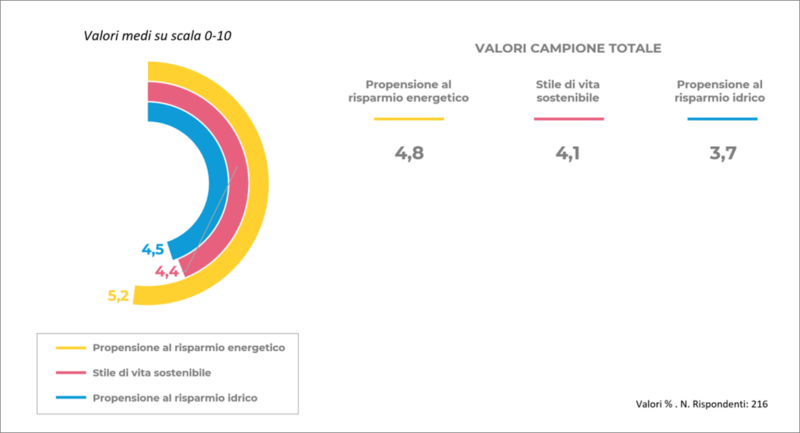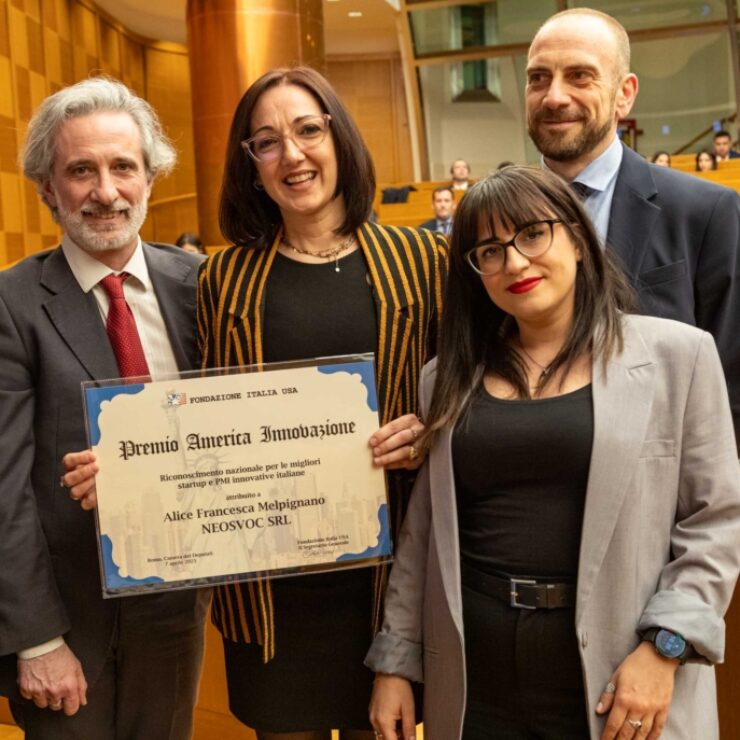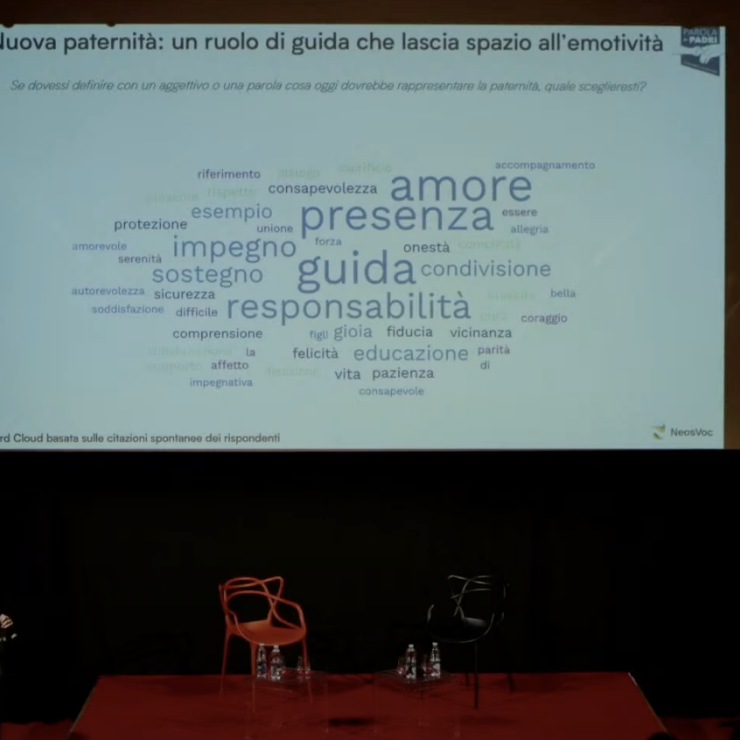During the Web Marketing Festival 2022, we decided to offer a very special live demo of NeosVoc, involving the audience (mostly marketers and communicators) present at the event. Using the Green Potential Detection Model, we explored the world of those who, through their work, communicate with others and influence their choices, questioning how personally engaged this group is on the topic of environmental sustainability.
This is the third article. In the first one, we explained what the Green Potential Detection Model is and shared the overall results of the Rimini survey. In the second article, we examined the world of psychographic traits and their propensity towards sustainable behaviors.

Psychographic traits, as we have seen, enrich the knowledge provided by demographic traits, further segmenting the sample. Considering the differences in propensity towards sustainable behaviors generated by each individual’s psychographic traits, let’s see what happens when we cross-reference this information with the demographic data of the surveyed sample.
We segmented the sample into two sub-groups: Under 35 and Over 35. As one might expect, age is closely related to the professional role within a company, with younger participants predominantly holding operational roles while those over 35 are mostly in managerial positions.
Through a careful analysis of psychographic traits and their natural propensity towards sustainable behaviors, we noticed a distinction: those over 35, with more “mature” age, exhibit traits less correlated to sustainable behavior in theory, yet they declare more sustainable and environmentally conscious behaviors in practice. On the other hand, younger and more operational individuals, despite showing a natural inclination towards environmentally friendly behaviors, do not always translate this predisposition into equally sustainable actions.
This is not a contradiction but rather a narrative of evolution. What is idealistic aspiration in the young manifests as concrete actions in the more mature individuals. These actions are undoubtedly influenced by education (like the advice from grandparents to always turn off the lights when leaving a room), experience, maturity, and specific needs such as caring for a family, setting a good example for children, and so forth.
How I am vs. how I act
In particular, among the Over 35s, we find a higher concentration of traits that would suggest a consumerist profile: self-assertion, impulsiveness, extroversion. However, their behaviors align more towards conscientiousness. Specifically, in terms of behaviors, the Over 35s show much greater engagement in virtuous behaviors and environmental conservation, scoring above average in all three categories: Water Conservation 4.5; Energy Conservation 5.2; Sustainable Lifestyle 4.4.
Let’s delve into the detailed composition of the two groups in terms of psychographic traits and behaviors.

Under 35: connected with the world. Ideally

They need to feel accepted (42.4%) and feel disappointed if they don’t receive positive feedback in this regard (41.4%). Moreover, they are individuals who care about others (66%), even when making their own choices (49.8%).
Their vision of the future is not always clear (28% are unsure of what they want). What is certain is that they cannot afford impulse purchases in the present (63%), nor can they plan their purchases; instead, they prefer to respond to immediate needs and avoid indulging in unnecessary items.
Despite these material “limitations,” they exhibit a strong emotional connection. They are deeply in tune with their emotions, believe in their ideals—though these do not always translate into concrete actions. Their strong artistic interests enable them to broaden their knowledge and open their minds to new stimuli and pleasures.
Curious, empathetic individuals who are attentive to the world around them. In terms of psychographic traits, they are individuals for whom environmental awareness is a fundamental part of life, beyond question.
Over 35: what I do for myself, benefits the world as well

In our sample, the Over 35s, as we have seen, are mostly individuals in managerial positions. Consequently, over time they have developed skills and characteristics typical of very self-assured and success-oriented individuals, but also more attentive to material matters. Over 35s, in fact, know what they want from life (51%) and can even afford impulse purchases (“see it, buy it” for 25% of them), to satisfy that momentary desire, even if not strictly necessary.
However, they are also very open to others, enjoy being around people, and generally trust the individuals they engage with. Consequently, they are quite outgoing and sociable, especially given the numerous social situations they find themselves participating in.
In their daily lives, they are certainly not lazy (and probably cannot afford to be), but they are aware of the importance of taking practical actions that are as beneficial as possible for the planet’s preservation. Therefore, they strive to have as many “ethical” behaviors as possible: an example is their preference for recycling items to give them a second life. Thirty-four percent of them have few artistic interests.
The behaviors
In light of these dispositional traits, the differences are subtle yet significant. Upon closer inspection, younger individuals exhibit traits that naturally lead them to be more environmentally conscious; whereas older individuals seem more concerned with themselves than the planet’s health – although they are so concerned with themselves that they also benefit the planet.
But specifically, what are the behaviors of these two age groups? We are referring to the behaviors we have already encountered: Water Conservation, Energy Conservation, and Lifestyle. Let’s delve into them specifically.
Water Conservation
Over 35s do not drink bottled water, preferring tap water (43.5% vs 22.5%); they use a dishwasher instead of washing dishes by hand (60.8% vs 49.5%), and they have mixer taps (68.8% vs 32.2%). Only on one point do the younger ones show more attention than adults: they prefer a shower to a bathtub (preferred by 86% of Under 35s compared to 72.3% of Over 35s).
Energy Conservation
On this aspect too, Over 35s are more attentive compared to younger individuals. They declare to use household appliances during low-energy consumption hours (53% vs 35%) and ensure that radiators at home do not exceed 20°C (36.9% vs 32.5%).
Lifestyle
On lifestyle, the greater attention of Over 35s is confirmed. One out of three does not buy out-of-season products, compared to 17% of young people; 28% purchase eco-friendly detergents, compared to 10% of young people. 47% are mindful of reducing packaging, compared to 36.8% of young people. Additionally, 28.6% of Over 35s shop at local or neighborhood stores, whereas only 5.3% of younger individuals agree with this habit.
How Experience Turns into Expertise and Strengthens Inclinations
Today’s adults were yesterday’s young people. Over time, they translate their natural predispositions into concrete behaviors – thankfully. However, perhaps the idealistic drive softens, absorbed into a daily routine filled with actions rather than just words.
Another interesting point concerns their professional position. As we have seen, virtuous behaviors are predominantly found in managerial roles. While this can be explained by the overlap between managers and those over 35, it also highlights another important theme: in their career paths, managers have encountered various contexts and developed skills that make them realize the importance of adopting behaviors more mindful of environmental impact. As we have observed, behaviors stem not only from internal predispositions but also from external environments and experiences accumulated over time.
From this, we can infer that older individuals have gained diverse experiences and met different people. They have adopted environmentally conscious behaviors to gain greater social acceptance. Being recognized as virtuous individuals capable of actions that demonstrate integrity is a priority, even if it means going against their natural predispositions (which are also shaped by accumulated experiences).
As mentioned earlier, the cognitive dissonance resulting from an inner attitude more self-oriented and a society demanding greater environmental awareness is reduced by adopting behaviors considered virtuous and characteristic of esteemed individuals socially recognized as ‘good people’.
Sustainable behaviors cost (and depend on the individual)
But then why don’t young people’s natural predispositions towards environmental sustainability automatically translate into sustainable behaviors? The explanation could lie in the fact that, as we have seen and can easily imagine, younger people in their work roles primarily operate in operational positions, which do not guarantee the same economic conditions and lifestyle as a manager. Therefore, in this case, there is cognitive dissonance: on one hand, there is a universalistic inclination, but on the other hand, there is less economic availability to buy local products or shop at neighborhood stores. Hence, they choose the most sustainable solution for their socio-professional condition, which is what most young people do: they buy from chains, eat industrial food, and live in affordable apartments that certainly do not have a low environmental impact.
From this, we can deduce that adopting behaviors in favor of environmental sustainability today relies on individual consciences (and wallets). There is no push towards collective action or institutional stance in this regard. So, those who can afford certain choices make them, while those who cannot silence their predisposition and try to find the most suitable solution for the current situation.
Given this scenario, how can we communicate sustainability today? That’s what we’ll explore in the next chapter.



